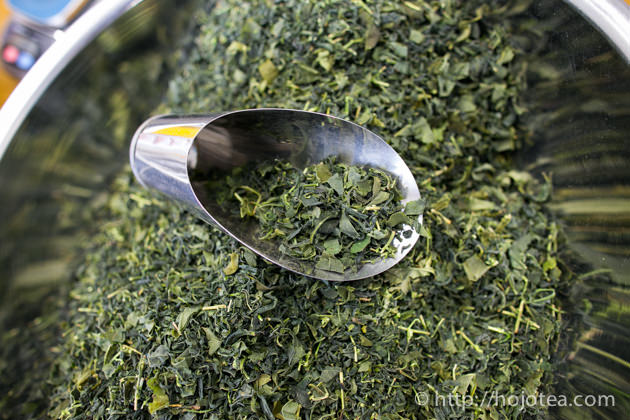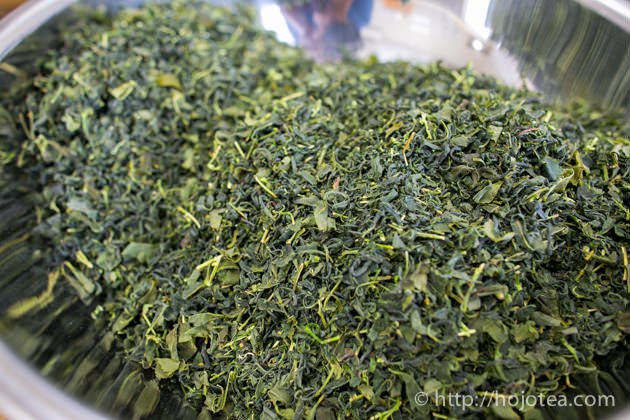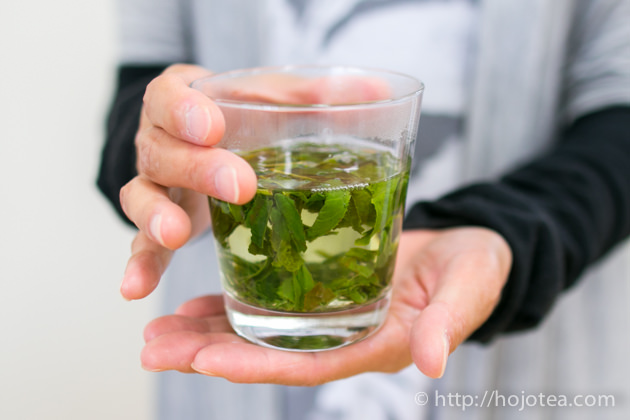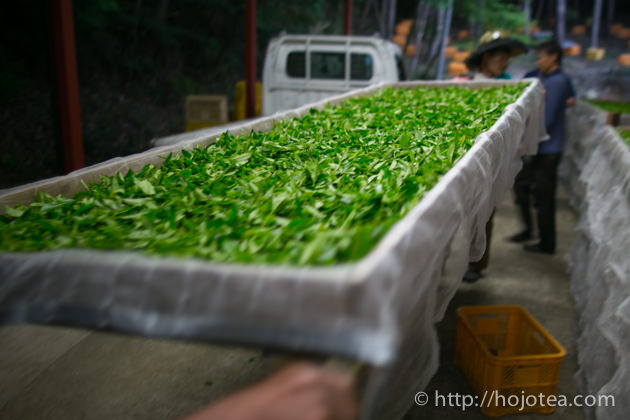- HOME >
- New Arrival at HOJO Online Shop
New Release of Tsukigase Asamomi Sencha

We just released Tsukigase Asamomi Sencha as one of our latest Japanese tea lineups. This tea is produced from the complete natural farming garden which no nitrogen fertilizer and no pesticide is used.
In Japanese, Asamomi means light rolling. Thanks to the light rolling, this tea can be brewed more times than ordinary Japanese green tea. Besides the multi-brewing character, this tea gives distinctive floral scent thanks to the special production method.

We decided not to make sencha in needle shape
Nowadays, it is undoubtedly that the needle-shape has become the standard of Japanese green tea. Everyone seems to take the needle shape of Japanese green tea for granted. Every Japanese tea manufacturers try very hard always roll tea leaves into needle shape.
In fact, the shape of tea is not related to the taste or flavor of tea. Ironically, the intensive rolling to make tea into the needle shape resulted in tea becomes less lasting in brewing. When brewing Japanese green tea, the 1st brewing tends to be very thick, yet the subsequent brewing often becomes very light. Due to very intensive rolling, the cell of tea leaf was effectively mercerized and the tea constituents were extracted faster.
In other words, we can make Japanese green tea lasts more brewing if we minimize the rolling and swiftly dry the tealeaf right after the steaming process.

Lightly-rolled tea gives fresh floral flavor
For rolling tea leaf into needle shape, it undergoes a few steps of rolling process:
- Preliminary rolling
- Intermediate rolling
- Rolling
- Final Rolling
In fact, these processes are not only rolling the tea leaves but also supplying hot air to dry tea leaves. The temperature of hot air often reaches even up to 100 degree C. As a result, the fresh tealeaf flavor somehow lost during the intensive rolling process.
We drew sample from the each process and taste to understand the changes of flavor. Interestingly, we found that the sample with less rolling gives very refreshing flavor like fresh flower bouquet, while the tea after more rolling gives typical flavor like steamed rice. It seems that this typical steamed rice flavor of Sencha is composed by the heat applied during rolling process.
With this finding, in order to retain as much of the fresh floral note of the green tealeaf, we drastically shorten the rolling process so as to minimize the heat damages to the flavor of the fresh tealeaf.
By the way, the fresh tealeaf scent has its drawback. The fresh tealeaf from the natural farming garden without fertilizer gives floral scent. On the other hand, the fresh tealeaf from the fertilized garden gives very green grassy scent that is rather a less attractive flavor. Since the majority of tea garden in Japan is grown with fertilizers, the intensive rolling process and heating was rather promoted by tea manufacturers as it changes the greenish scent into the flavor like steamed rice.
Since we have carefully selected the garden that uses no fertilizer at all, we wish to rather enhance the floral scent of the fresh tealeaf. Therefore, we use very short steaming time in order to preserve the original flavor of fresh tealeaf.

The tealeaf of Tsukigase Asamomi Sencha is quite coarse. It is suitable to brew it directly in a glass. For this drinking style, 2g in 200ml of hot water is ideal.


Tea has undergone moderate withering in forest
After the fresh tea leaves were collected, the tea leaves were withered in the forest for 12 hours in order to further enhance the floral scent. However, if the withering is too long, it makes tea into white or oolong tea character. So we requested our manufacturer to carefully determine the precise timing of withering so that it is just nice to enhance the floral scent of this Japanese green tea.
Unique brewing technique
Tsukigase Asamomi Sencha contains very less Umami. Umami is the substance composed by nitrogen derived from fertilizer. Because of these tea trees were grown without nitrogen fertilizer, this Sencha is rather rich in poly phenols and minerals.
Considering this characteristic, the flavor of Tsukigase Asamomi Sencha is more appealing and richer if tea is brewed with boiling hot water for a shorter time.
For the first brewing, I use boiling water and brew for 10-20 seconds. For the second brewing and subsequent brewing, I usually keep brewing time in less than a few seconds.
This tea is also suitable for cold water brewing. For making cold water brewed tea, I suggest 5g of tea leaf soaked in 1 liter of water. You can prepare it in a glass bottle and leave it in a refrigerator for about 4-5 hours. If you prefer a lighter taste, please add in some water to dilute it. It is advisable to use the water cooled down from the boiling water. It gives more flavors.
Related Articles
How to get the latest update on HOJO?
1. Follow Twitter, 2. Click "Like" on Facebook, and 3. Subscribe in newsletter. You can have the latest tea news from HOJO.
 Subscribe the Newsletter to enjoy the privileges
Subscribe the Newsletter to enjoy the privileges- You may receive a free sample upon purchase, or you may have the priority to purchase special products. So please remember to subscribe our newsletter as well as the social network.
- Myanmar White Tea Bud 2013 from Guo Gan, Myanmar
- We have released a raw Pu-erh tea, 緬甸白芽茶 2013 (Myanmar White Tea Bud 2013), produced by ethnic minorities in t …
- Yong De Wild White Tea 2025 Loose Leaf Limited Release
- We have released Yong De Wild White Tea Loose 2025. For the 2025 harvest, only the loose-leaf type was …
NEW ARTICLES
 Myanmar White Tea Bud 2013 from Guo Gan, Myanmar
Myanmar White Tea Bud 2013 from Guo Gan, Myanmar- We have released a raw Pu-erh tea, 緬甸白芽茶 2013 (Myanmar White Tea Bud 2013), produced by ethnic minorities in t …
 Yong De Wild White Tea 2025 Loose Leaf Limited Release
Yong De Wild White Tea 2025 Loose Leaf Limited Release- We have released Yong De Wild White Tea Loose 2025. For the 2025 harvest, only the loose-leaf type was …
 Experience the True Freshness of Raw Pu-erh : Tang Jia 2025 Loose Leaf Release
Experience the True Freshness of Raw Pu-erh : Tang Jia 2025 Loose Leaf Release- We have released Tang Jia Raw Pu-erh Tea 唐家古樹生茶 2025 Loose Leaf. Among HOJO’s raw pu-erh teas, Tang Jia Raw Pu …
 Yunnan Chun Jian Green Tea from High Mountain Gardens
Yunnan Chun Jian Green Tea from High Mountain Gardens- Yunnan Chun Jian Green Tea is now available. This tea is made from naturally grown leaves harvested from high …
 Limited Loose Leaf Release of 2025 Da Xue Shan Wild Raw Pu-erh Tea
Limited Loose Leaf Release of 2025 Da Xue Shan Wild Raw Pu-erh Tea- We have released the 2025 loose-leaf version of Da Xue Shan Wild Raw Pu-erh Tea. This tea comes from wild tea …
 Discover a New Way to Enjoy Tea: Cooking Rice with Tea
Discover a New Way to Enjoy Tea: Cooking Rice with Tea- Cooking rice with tea is a simple idea, but it brings surprisingly satisfying results. The tea’s flavour seeps …
 2025 Da Xue Shan Wild White Tea Now Available from Yunnan
2025 Da Xue Shan Wild White Tea Now Available from Yunnan- The 2025 harvest of Da Xue Shan Wild White Tea is now available. Crafted from truly wild Camellia taliensis tr …
 Fresh 2025 Yunnan White Tea – Select Your Favourite Lot Before Blending
Fresh 2025 Yunnan White Tea – Select Your Favourite Lot Before Blending- Freshly crafted in Yunnan and just arrived in KL, our new 2025 white tea is now available at our Gardens Mall …
 2024 Dong Shan Raw Pu-erh Tea – Crafted with the Producer for Desired Quality
2024 Dong Shan Raw Pu-erh Tea – Crafted with the Producer for Desired Quality- We have released the 2024 cake of Dong Shan Raw Pu-erh Tea. Earlier, we offered the loose-leaf version from th …
 Development of Firewood Roasted Hojicha Using Naturally Grown Tea from Yunnan
Development of Firewood Roasted Hojicha Using Naturally Grown Tea from Yunnan- We are currently staying in Yunnan Province for tea production. As the season nears its end, tea trees with pa …
Category
- New Arrival at HOJO Online Shop
- Featured Articles
- Newsletter
- Types of Tea
- Origin of Tea
- Teapot and Tea Equipment
- Tea Column
- How to enjoy tea
- Tea Processing
- How to choose quality tea
- Tea constituents and functional effect
- Safety of Tea
- Foods
- Tea Business Operation
- Hobby and Outdoor Activity
- Ranking of Tea
- Video
- FAQ
- Media Release
Profile

- AKIRA HOJO
- I invite you to experience my tea selections.I was born in Nagano, Japan. In university, I studied agricultural chemistry, and I have the master degree in food science. I worked in Japanese food industry for 10 years. I involved in R&D, QC and QA. As a factory manager, I implemented ISO9000 series and managed the factory.
- The Art of Tea Magazine
- We posted the article on “The Art of Tea Magazine No.9, the magazine is published in Taiwan. We featured …
- New Straits Times
- The Malaysian National Newspaper, New Straits Times featured HOJO Tea on 17-Oct-2007.
Shop Info

Address:Lot No. T-215, 3rd Floor, The Gardens Mall, Mid Valley City, Lingkaran Syed Putra, 59200 Kuala Lumpur
Tel: +603-2287-4537
Business Hour: 10am to 10pm

















